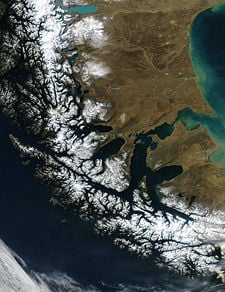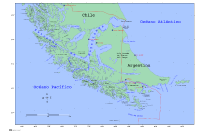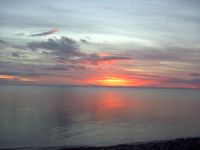Difference between revisions of "Strait of Magellan" - New World Encyclopedia
Mary Anglin (talk | contribs) m (→Course) |
Mary Anglin (talk | contribs) |
||
| Line 3: | Line 3: | ||
The '''Strait of Magellan''' (often referred to as the '''Straits of Magellan''' and rarely as the '''Magellanic Strait''') is a channel at the tip of [[South America]] linking the [[Atlantic Ocean|Atlantic]] and [[Pacific Ocean]]s. This navigable sea route separates the mainland from [[Tierra del Fuego]] and other [[island]]s south of the [[continent]]. Except for a few miles at its easternmost extremity in [[Argentina]], it lies within [[Chile]]an territorial waters. The strait’s major port is Punta Arenas on the Brunswick Peninsula. | The '''Strait of Magellan''' (often referred to as the '''Straits of Magellan''' and rarely as the '''Magellanic Strait''') is a channel at the tip of [[South America]] linking the [[Atlantic Ocean|Atlantic]] and [[Pacific Ocean]]s. This navigable sea route separates the mainland from [[Tierra del Fuego]] and other [[island]]s south of the [[continent]]. Except for a few miles at its easternmost extremity in [[Argentina]], it lies within [[Chile]]an territorial waters. The strait’s major port is Punta Arenas on the Brunswick Peninsula. | ||
| − | The strait is approximately {{convert|600|km|sp=us}} long, and ranges from {{convert|3|to|35|km|mi} at its narrowest and widest points, respectively. An important natural passage between the oceans, it is considered a difficult route to [[navigate]] because of the inhospitable [[climate]] and the narrowness of the passage. | + | The strait is approximately {{convert|600|km|sp=us}} long, and ranges from {{convert|3|to|35|km|mi}} at its narrowest and widest points, respectively. An important natural passage between the oceans, it is considered a difficult route to [[navigate]] because of the inhospitable [[climate]] and the narrowness of the passage. |
The first [[Europe]]an to navigate the strait was [[Ferdinand Magellan]], a [[Portugal|Portuguese]] maritime explorer sailing for [[Spain]], who discovered the strait in 1520 during the first successful attempt at world circumnavigation. | The first [[Europe]]an to navigate the strait was [[Ferdinand Magellan]], a [[Portugal|Portuguese]] maritime explorer sailing for [[Spain]], who discovered the strait in 1520 during the first successful attempt at world circumnavigation. | ||
| Line 11: | Line 11: | ||
==Geography== | ==Geography== | ||
| + | [[Image:Chile.estrechodemagallanes.png|thumb|200px|Strait of Magellan, in Tierra del Fuego]] | ||
| + | [[image:Strait_of_magellan_dawn.jpg|thumb|200px|The Strait of Magellan at dawn]] | ||
| + | [[image:Strait_of_magellan_decline.jpg|thumb|200px|The Strait of Magellan at sunset]] | ||
===Course=== | ===Course=== | ||
The Strait of Magellan is approximately {{convert|600|km|sp=us}} long, and ranges from {{convert|3|to|35|km|mi}} at its narrowest and widest points, respectively. The northwestern portion of the strait is connected with other sheltered waterways via the [[Smyth Channel]]. This area is similar to those of the [[Inside Passage]] of Alaska. Southward from [[Cape Froward]], the principal shipping route follows through the [[Magdalena Channel]]. It links the [[strait]] with the [[Beagle Channel]]. | The Strait of Magellan is approximately {{convert|600|km|sp=us}} long, and ranges from {{convert|3|to|35|km|mi}} at its narrowest and widest points, respectively. The northwestern portion of the strait is connected with other sheltered waterways via the [[Smyth Channel]]. This area is similar to those of the [[Inside Passage]] of Alaska. Southward from [[Cape Froward]], the principal shipping route follows through the [[Magdalena Channel]]. It links the [[strait]] with the [[Beagle Channel]]. | ||
| − | The eastern opening is the wide bay on the border of [[Chile]] and [[Argentina]] between [[Punta Dúngeness]] on the mainland and Cabo del Espiritu Santo on Tierra del | + | The eastern opening is the wide bay on the border of [[Chile]] and [[Argentina]] between [[Punta Dúngeness]] on the mainland and Cabo del Espiritu Santo on [[Tierra del Fuego]], the border defined in the [[Treaty of Peace and Friendship of 1984 between Chile and Argentina]]. Immediately west are located [[Primera Angostura]] and ''Segunda Angostura'', which are narrows formed by two different-aged [[terminal moraine]]s. Here also lies [[Magdalena Island, Magallanes, Chile|Magdalena Island]], which is part of [[Los Pingüinos Natural Monument]]. In this part of the strait, its southern boundary follows first the shoreline of the Isla Grande de Tierra del Fuego, then follows the northern end of the ''Canal Whiteside'' and continues along the shoreline of [[Dawson Island]]. |
| − | The western part of the strait stretches | + | The western part of the strait stretches northwestward from the northern end of Magdalena Channel to the strait's [[Pacific Ocean|Pacific]] entrance. This portion of the strait is flanked on the south by [[Capitán Aracena Island]], [[Clarence Island, Chile|Clarence Island]], [[Santa Inés Island]], [[Desolación Island]] and other smaller islands, and on the north by [[Brunswick Peninsula]], [[Riesco Island]], [[Muñoz Gamero Peninsula]] and other minor islands. Here, two narrow channels that open into the strait connect with [[Seno Otway]] and [[Seno Skyring]]. [[Francisco Coloane Coastal and Marine Protected Area]], which protects [[Humpback Whale]]s, is located in this area. This part of the strait lies on the elongated [[Magallanes-Fagnano Fault]], which marks a plate boundary between the [[South American Plate]] and the [[Scotia Plate]]. This fault continues southward under the [[Almirantazgo Fjord]] and then low the [[Fagnano Lake]]. |
===Features=== | ===Features=== | ||
| Line 25: | Line 28: | ||
==History== | ==History== | ||
| − | + | ||
| − | + | [[image:Strait_of_Magellan.jpeg|thumb|200px|The Strait of Magellan]] | |
| − | |||
| − | [[image:Strait_of_Magellan.jpeg|thumb|200px| | ||
[[Ferdinand Magellan]] (the original name, in Portuguese, Fernão de Magalhães), a Portuguese sailor in service to the Spanish King, became the first European to navigate the strait in 1520, during his global circumnavigation voyage. Because Magellan's ships entered it on November 1, [[All Saints' Day]], it was originally named ''Estrecho de Todos los Santos'' (Strait of All Saints). Later the Spanish king changed the name to ''Estrecho de Magallanes'' in honor of Magellan. Since its discovery the [[Spanish Empire]] and the [[Kingdom of Chile]] saw it as its southern boundary. The first Spanish colonization attempt was led by [[Pedro Sarmiento de Gamboa]] who founded ''Nombre de Jesús'' and ''[[Puerto Hambre|Rey Don Felipe]]'' on its northern shores. The cities suffered severe food shortages, and years afterwards in 1587 the English [[navigator]] Sir [[Thomas Cavendish]] landed at the site of ''Rey Don Felipe'' and found only ruins of the settlement. He renamed the place ''[[Puerto Hambre|Port Famine]]''. Other early explorers included [[Francis Drake]]. The strait was first carefully explored and thoroughly charted by [[Phillip Parker King]], who commanded the British survey vessel [[HMS Adventure (1809)|HMS ''Adventure'']], and in company with [[HMS Beagle|HMS ''Beagle'']], spent five years surveying the complex coasts around the Strait. The result was presented at a meeting of the [[Royal Geographical Society]] in 1831. | [[Ferdinand Magellan]] (the original name, in Portuguese, Fernão de Magalhães), a Portuguese sailor in service to the Spanish King, became the first European to navigate the strait in 1520, during his global circumnavigation voyage. Because Magellan's ships entered it on November 1, [[All Saints' Day]], it was originally named ''Estrecho de Todos los Santos'' (Strait of All Saints). Later the Spanish king changed the name to ''Estrecho de Magallanes'' in honor of Magellan. Since its discovery the [[Spanish Empire]] and the [[Kingdom of Chile]] saw it as its southern boundary. The first Spanish colonization attempt was led by [[Pedro Sarmiento de Gamboa]] who founded ''Nombre de Jesús'' and ''[[Puerto Hambre|Rey Don Felipe]]'' on its northern shores. The cities suffered severe food shortages, and years afterwards in 1587 the English [[navigator]] Sir [[Thomas Cavendish]] landed at the site of ''Rey Don Felipe'' and found only ruins of the settlement. He renamed the place ''[[Puerto Hambre|Port Famine]]''. Other early explorers included [[Francis Drake]]. The strait was first carefully explored and thoroughly charted by [[Phillip Parker King]], who commanded the British survey vessel [[HMS Adventure (1809)|HMS ''Adventure'']], and in company with [[HMS Beagle|HMS ''Beagle'']], spent five years surveying the complex coasts around the Strait. The result was presented at a meeting of the [[Royal Geographical Society]] in 1831. | ||
Revision as of 23:56, 13 February 2009
The Strait of Magellan (often referred to as the Straits of Magellan and rarely as the Magellanic Strait) is a channel at the tip of South America linking the Atlantic and Pacific Oceans. This navigable sea route separates the mainland from Tierra del Fuego and other islands south of the continent. Except for a few miles at its easternmost extremity in Argentina, it lies within Chilean territorial waters. The strait’s major port is Punta Arenas on the Brunswick Peninsula.
The strait is approximately 600 kilometers (370 mi) long, and ranges from 3 to 35 kilometers (1.9 to 22 mi) at its narrowest and widest points, respectively. An important natural passage between the oceans, it is considered a difficult route to navigate because of the inhospitable climate and the narrowness of the passage.
The first European to navigate the strait was Ferdinand Magellan, a Portuguese maritime explorer sailing for Spain, who discovered the strait in 1520 during the first successful attempt at world circumnavigation.
The strait was an important sailing-ship route before the completion of the Panama Canal in 1914 shortened the Atlantic-Pacific passage by several thousand miles. Though it follows a difficult and often foggy path among numerous islands and channels, it allows an inland passage protected from almost continuous ocean storms. It continues to be used by ships rounding South America.
Geography
Course
The Strait of Magellan is approximately 600 kilometers (370 mi) long, and ranges from 3 to 35 kilometers (1.9 to 22 mi) at its narrowest and widest points, respectively. The northwestern portion of the strait is connected with other sheltered waterways via the Smyth Channel. This area is similar to those of the Inside Passage of Alaska. Southward from Cape Froward, the principal shipping route follows through the Magdalena Channel. It links the strait with the Beagle Channel.
The eastern opening is the wide bay on the border of Chile and Argentina between Punta Dúngeness on the mainland and Cabo del Espiritu Santo on Tierra del Fuego, the border defined in the Treaty of Peace and Friendship of 1984 between Chile and Argentina. Immediately west are located Primera Angostura and Segunda Angostura, which are narrows formed by two different-aged terminal moraines. Here also lies Magdalena Island, which is part of Los Pingüinos Natural Monument. In this part of the strait, its southern boundary follows first the shoreline of the Isla Grande de Tierra del Fuego, then follows the northern end of the Canal Whiteside and continues along the shoreline of Dawson Island.
The western part of the strait stretches northwestward from the northern end of Magdalena Channel to the strait's Pacific entrance. This portion of the strait is flanked on the south by Capitán Aracena Island, Clarence Island, Santa Inés Island, Desolación Island and other smaller islands, and on the north by Brunswick Peninsula, Riesco Island, Muñoz Gamero Peninsula and other minor islands. Here, two narrow channels that open into the strait connect with Seno Otway and Seno Skyring. Francisco Coloane Coastal and Marine Protected Area, which protects Humpback Whales, is located in this area. This part of the strait lies on the elongated Magallanes-Fagnano Fault, which marks a plate boundary between the South American Plate and the Scotia Plate. This fault continues southward under the Almirantazgo Fjord and then low the Fagnano Lake.
Features
History
Ferdinand Magellan (the original name, in Portuguese, Fernão de Magalhães), a Portuguese sailor in service to the Spanish King, became the first European to navigate the strait in 1520, during his global circumnavigation voyage. Because Magellan's ships entered it on November 1, All Saints' Day, it was originally named Estrecho de Todos los Santos (Strait of All Saints). Later the Spanish king changed the name to Estrecho de Magallanes in honor of Magellan. Since its discovery the Spanish Empire and the Kingdom of Chile saw it as its southern boundary. The first Spanish colonization attempt was led by Pedro Sarmiento de Gamboa who founded Nombre de Jesús and Rey Don Felipe on its northern shores. The cities suffered severe food shortages, and years afterwards in 1587 the English navigator Sir Thomas Cavendish landed at the site of Rey Don Felipe and found only ruins of the settlement. He renamed the place Port Famine. Other early explorers included Francis Drake. The strait was first carefully explored and thoroughly charted by Phillip Parker King, who commanded the British survey vessel HMS Adventure, and in company with HMS Beagle, spent five years surveying the complex coasts around the Strait. The result was presented at a meeting of the Royal Geographical Society in 1831.
Incorporation to Chile
Chile took possession of the channel on May 23, 1843. Chilean president Bulnes ordered the expedition after speaking with the Chilean libertador Bernardo O'Higgins who feared an occupation by Great Britain or France. The first Chilean settlement was Fuerte Bulnes situated in a forested zone on the north side of the strait. Fuerte Bulnes was later abandoned and the city of Punta Arenas was founded in 1848 further north where the Magellanic forests met the Patagonian plains. In front of Punta Arenas, on the other shore of the strait in Tierra del Fuego the village of Porvenir emerged during a gold rush in the late 1800s.
Until the Panama Canal was finished in 1914, the Strait of Magellan was the main route for steam ships traveling from the Atlantic Ocean to the Pacific; it was often considered the only safe way to move between the Atlantic and Pacific Oceans. Protected by Tierra del Fuego to the south and the bulk of South America to the north, ships crossed with relative ease, removed from the dangers of Drake Passage. Despite these natural defenses, sailing ships such as the clippers preferred Drake Passage as they had more room to maneuver. The Drake Passage is the relatively narrow stretch of ocean separating Cape Horn (the southern tip of South America) from Antarctica, the waters of which are notoriously turbulent, unpredictable, and frequented by icebergs and sea ice.
See also
- Monte Sarmiento
- Agostini Fjord
Notes
ReferencesISBN links support NWE through referral fees
- Google. Timeline for Strait of Magellan Retrieved February 13, 2009.
- ISMAR Bologna. The Straits of Magellan and Oceanographical Setting Retrieved February 13, 2009.
- Kent, Rockwell. 2000. Voyaging southward form the Strait of Magellan. Hanover, NH [u.a.]: Univ. Press of New England. ISBN 9780819564092
- Markham, Clements R. 1911. Early Spanish voyages to the strait of Magellan. Works issued by the Hakluyt Society, 2nd ser., no. 28. London: Printed for the Hakluyt Society. OCLC 9060328
- Morris, Michael A. 1989. The Strait of Magellan. International straits of the world, v. 11. Dordrecht: M. Nijhoff. ISBN 9780792301813
- U.S. Geological Survey. Past Glaciations and "Little Ice Ages" Retrieved February 13, 2009.
Credits
New World Encyclopedia writers and editors rewrote and completed the Wikipedia article in accordance with New World Encyclopedia standards. This article abides by terms of the Creative Commons CC-by-sa 3.0 License (CC-by-sa), which may be used and disseminated with proper attribution. Credit is due under the terms of this license that can reference both the New World Encyclopedia contributors and the selfless volunteer contributors of the Wikimedia Foundation. To cite this article click here for a list of acceptable citing formats.The history of earlier contributions by wikipedians is accessible to researchers here:
The history of this article since it was imported to New World Encyclopedia:
Note: Some restrictions may apply to use of individual images which are separately licensed.





